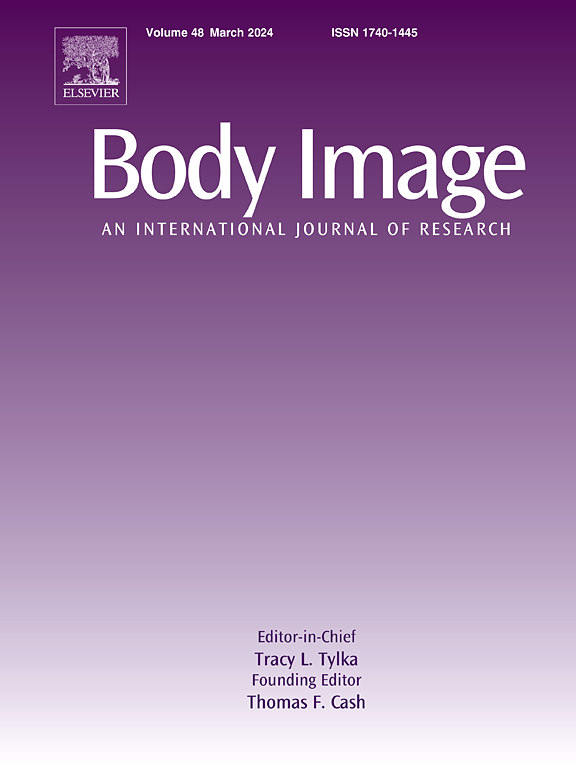TikTok 会导致饮食失调吗?饮食失调症患者与健康对照者的TikTok算法比较
IF 5.2
1区 心理学
Q1 PSYCHIATRY
引用次数: 0
摘要
TikTok 采用复杂的算法,随着时间的推移为用户提供越来越个性化的内容。我们对 42 名饮食失调患者(76% 患有神经性厌食症)和 49 名健康对照者在一个月内观看的 103 万部 TikTok 视频进行了分析,研究了这些算法加剧饮食失调症状的可能性。在这个视频库中,我们确定了与饮食失调精神病理学相关的四个视频类别:外貌导向型视频、节食视频、运动视频和有毒饮食失调(类似于 "亲厌食症")视频。多层次模型预测了用户算法提供这些视频的可能性以及用户 "喜欢"(即自愿参与)这些视频的可能性。饮食失调用户的算法提供了更多以外表为导向的视频(+146 %)、节食视频(+335 %)、运动视频(+142 %)和有毒饮食失调视频(+4343 %)。用户算法中对这些视频的强烈偏好与更严重的饮食失调症状有关。虽然患有饮食失调症的用户 "喜欢 "这些问题视频类别的可能性略高(例如,节食视频:+23 %,对照组为+23 %),但他们的算法更有可能首先提供这些视频(节食视频:+335 %,对照组为+335 %)。我们的研究结果提供了初步证据,证明 TikTok 算法可能会通过对用户自愿行为(即 "喜欢 "视频)脱敏的内容个性化过程来加剧饮食失调症状。本文章由计算机程序翻译,如有差异,请以英文原文为准。
Does TikTok contribute to eating disorders? A comparison of the TikTok algorithms belonging to individuals with eating disorders versus healthy controls
TikTok employs sophisticated algorithms to deliver users increasingly personalised content over time. We investigated the potential for these algorithms to exacerbate eating disorder symptoms by analysing 1.03 million TikTok videos delivered to 42 individuals with eating disorders (76 % anorexia nervosa) and 49 healthy controls over one month. Within this video corpus, we identified four video categories relevant to eating disorder psychopathology: appearance-oriented videos, dieting videos, exercise videos, and toxic eating disorder (akin to “pro-anorexia”) videos. Multi-level models predicted the likelihood of users’ algorithms delivering these videos and the likelihood of users “liking” (i.e., volitionally engaging with) these videos. Algorithms belonging to users with eating disorders delivered more appearance-oriented (+146 %), dieting (+335 %), exercise (+142 %), and toxic eating disorder videos (+4343 %). Stronger biases in users’ algorithms toward these videos were associated with more severe eating disorder symptoms. Whilst users with eating disorders were slightly more likely to “like” these problematic video categories (e.g., dieting videos: +23 % versus controls), their algorithms were far more likely to deliver these videos in the first place (dieting videos: +335 % versus controls). Our results provide preliminary evidence that the TikTok algorithm might exacerbate eating disorder symptoms via content personalisation processes that are desensitised to volitional user actions (i.e., “liking” videos).
求助全文
通过发布文献求助,成功后即可免费获取论文全文。
去求助
来源期刊

Body Image
Multiple-
CiteScore
8.70
自引率
28.80%
发文量
174
期刊介绍:
Body Image is an international, peer-reviewed journal that publishes high-quality, scientific articles on body image and human physical appearance. Body Image is a multi-faceted concept that refers to persons perceptions and attitudes about their own body, particularly but not exclusively its appearance. The journal invites contributions from a broad range of disciplines-psychological science, other social and behavioral sciences, and medical and health sciences. The journal publishes original research articles, brief research reports, theoretical and review papers, and science-based practitioner reports of interest. Dissertation abstracts are also published online, and the journal gives an annual award for the best doctoral dissertation in this field.
 求助内容:
求助内容: 应助结果提醒方式:
应助结果提醒方式:


